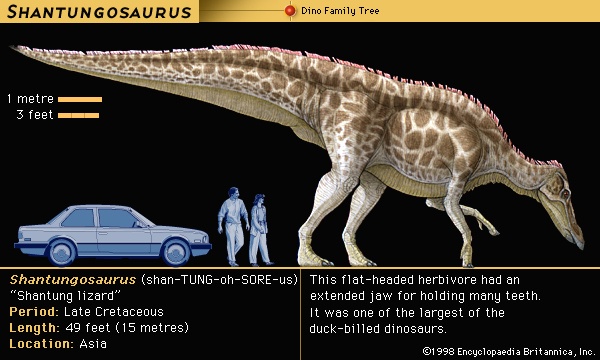Anatosaurus
dinosaur genus
subsumes Trachodon
 bipedal duck-billed dinosaurs (hadrosaurs) of the Late Cretaceous Period, commonly found as fossils in North American rocks 70 million to 65 million years old. Related forms such as Edmontosaurus and Shantungosaurus have been found elsewhere in the Northern Hemisphere.
bipedal duck-billed dinosaurs (hadrosaurs) of the Late Cretaceous Period, commonly found as fossils in North American rocks 70 million to 65 million years old. Related forms such as Edmontosaurus and Shantungosaurus have been found elsewhere in the Northern Hemisphere.Anatosaurus grew to a length of 9–12 metres (30–40 feet) and was heavily built. The skull was long and the beak broad and flat, much like a duck's bill. As in all iguanodontids (Iguanodon) and hadrosaurs, there were no teeth in the beak itself, which was covered by a horny sheath. However, several hundred rather blunt teeth were arranged in rows along the sides of the cheeks at any given time. There were dozens of teeth along each row, and several rows of exposed and partially worn replacement teeth were present behind the outer teeth. Not all were functional simultaneously, but, as teeth became worn or lost, they were replaced continually by new ones.
Some Anatosaurus specimens have been found desiccated and remarkably well preserved, with skin and internal structures remaining. Such evidence indicates that the outer hide was leathery and rough. Anatosaurus may have fed mostly on twigs, seeds, fruits, and pine needles, judging from fossilized stomach remains; no digested remains of aquatic plants have been found. The flat, blunt, hooflike claw bones of Anatosaurus and other duckbills suggest that they were much like today's browsing mammals in their habits, probably traveling in herds and feeding on a variety of land vegetation.
Anatosaurus was a member of the duckbill lineage called hadrosaurines, which, unlike lambeosaurine (Lambeosaurus) hadrosaurs, did not evolve elaborate crests on the skull. Trachodon was a name assigned to hadrosaur remains that consisted only of isolated teeth.
- sulfide
- sulfide mineral
- Sulfide minerals
- sulfite process
- sulfonamide
- sulfonation
- sulfone
- sulfonic acid
- sulfosalt
- Sulfosalts
- sulfoxide
- sulfur
- sulfur bacterium
- sulfur butterfly
- sulfur cycle
- sulfur dye
- sulfuric acid
- sulfur oxide
- Sulitelma
- Suliyavongsa
- sulky
- Sulla, Lucius Cornelius
- Sullana
- Sullivan
- Sullivan, Ed